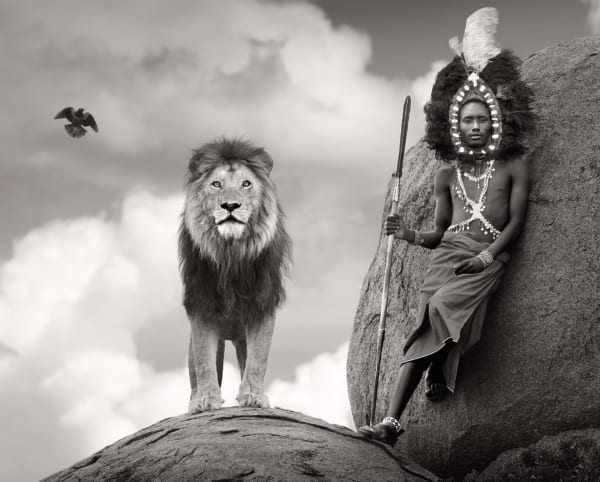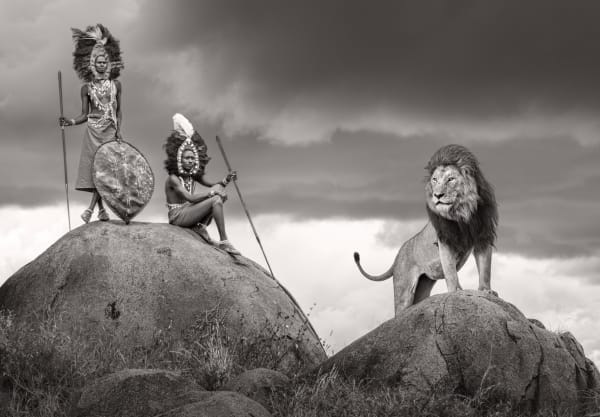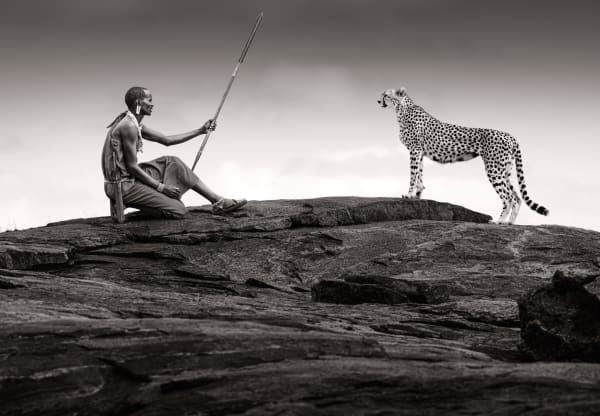
James Lewin
28 x 46 inches - Edition of 8
38 x 62.25 inches - Edition of 6
48 x 78.75 inches - Edition of 6
In an era where technology defines our daily lives, and the natural world feels increasingly distant, it might be difficult to imagine that there are still people in Africa living much as they did hundreds of years ago. These individuals remain deeply connected to nature, their way of life woven to the land, the seasons, and the animals with which they coexist. They are not separate from the natural world but part of it, their fate tied to that of the wild animals they have lived alongside for generations.
For the opening of this series, I chose to focus on the Maasai Tribe. Their story offers a compelling example of living in harmony with nature. Much of East Africa's remaining
wilderness and iconic safari destinations are Maasai ancestral lands, making this a natural starting point for a project that honours both traditional cultures and the natural world. This new series celebrates remarkable cultures and the iconic wildlife they coexist alongside. My work has long focused on showcasing the beauty and fragility of Africa's wildlife, but living here has revealed an equally pressing reality. The traditional ways of life for communities that have long depended on the natural world are now just as endangered as the natural world itself. These ancient cultures are now only found in highly remote regions or as curated performances for visitors. To discover the people featured in this series, I had to journey far beyond the reach of any tourist map, working with my network of friends and Maasai contacts across Kenya and Tanzania. The friendships and partnerships formed throughout this journey were vital to the success of this series, and I am sincerely grateful to everyone who helped me along the way.
Each artwork features both wild animals in their natural habitats and genuine Maasai individuals whose lives remain intertwined with the land. There were several ways I could have approached this series, some far easier than others. But for me, it was non-negotiable that the animals were photographed in the wild, on the ancestral lands of the very people shown alongside them, making this the most technically challenging project I have ever undertaken. Each artwork is a composite, made from two
separate photographs, taken with the same lens, in the same exact location, at the same time of day and under matching light and weather conditions. To bring these human-wildlife portraits to life, every wildlife frame was composed with the human
subject already in mind, the space carefully left for those yet to arrive. I searched for moments where the animal's presence aligned with the narrative, bringing a sense of completeness and quiet belonging to the final image. I've always believed that wild animals deserve to be photographed with the same intimacy and respect as people. It's all portraiture, whether I'm photographing a lion or a Maasai Warrior. Getting close and avoiding telephoto lenses allows me to capture the true essence and emotion of each character, and this principle was more crucial than ever for the making of this series.
You can't photograph a Maasai warrior from a distance and expect to connect with him, and the same goes for the animals. Working with wild animals comes with its challenges, as they, of course, cannot be directed. Proximity is earned through an investment of time and respect, which is the primary reason this series has taken three years to produce.
What began as a creative journey became a deeply personal experience. During the weeks I spent with the Maasai, they welcomed me with infectious warmth, shared inspiring stories around evening fires, and offered a sense of belonging that I will never forget. Some have become true friends. The memories we created are ones I'll carry for a lifetime, and their profound connection to the world around them has left a lasting impact on me. This series is a reflection of that experience, a reminder
that we are not separate from nature, nor above it, but part of it. May these images serve as quiet yet powerful testaments to the possibility that humanity and the natural world can still thrive together, side by side, just as the people in these photographs, and their ancestors, have done for generations.
-
 James LewinGuardians of the Plains, 2025
James LewinGuardians of the Plains, 2025 -
 James LewinOne Land, One Life, 2025
James LewinOne Land, One Life, 2025 -
 James LewinThe Boy and the Gentle Giant, 2025
James LewinThe Boy and the Gentle Giant, 2025 -
 James LewinThe Land That Made Us One, 2025
James LewinThe Land That Made Us One, 2025 -
 James LewinThe Last Nomads, 2025
James LewinThe Last Nomads, 2025 -
 James LewinThe Warriors, 2025
James LewinThe Warriors, 2025 -
 James LewinThis Land is Our Story, 2025
James LewinThis Land is Our Story, 2025 -
 James LewinTied to the Same Fate, 2025
James LewinTied to the Same Fate, 2025 -
 James LewinTogether, 2025
James LewinTogether, 2025
Join our mailing list
* denotes required fields
We will process the personal data you have supplied in accordance with our privacy policy (available on request). You can unsubscribe or change your preferences at any time by clicking the link in our emails.
This website uses cookies
This site uses cookies to help make it more useful to you. Find out more about cookies.








